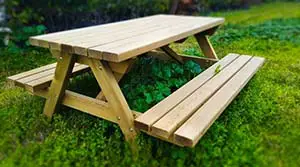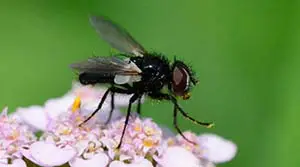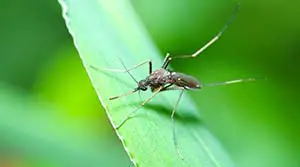
The hiss or rattle from a snake in your yard is enough to frighten you. Unfortunately, it may be too late by the time you receive that warning.
Luckily, you have many options to keep snakes from your yard. Growing snake repelling plants is one of those things. Examples of these plants include the following:
- Clove tree
- Cinnamon tree
- Lemongrass
- Tobacco
- Berry bushes
- Lavender
- Rosemary
- Bulb family plants
- Witch hazel
- Skunk cabbage
- Wormwood plants
What you end up planting will largely depend on where you are and the kind of soil you have. Also, your yard size will influence what plants you can grow within the available space.
This article provides information about several plants that keep snakes away and the basic gardening rules you should follow to reduce snake presence in your yard.
We also discuss snakes and the kinds of senses they have that determine a plant’s effectiveness in repelling them away.
What Kind of Senses Do Snakes Have?
Snakes, like other animals, have their fair share of senses. However, the strength of these senses differs from those of other animals or humans.
Understanding snakes’ senses will enable you to make better choices concerning snake-repelling plants.
1. Senses Heat & Use of Tongue
Generally, snakes have poor eyesight. As a result, they use their tongues to feel for their surroundings. However, some sense the heat from their surroundings, and their sensors transmit that message to their brains.
For that reason, it makes no sense to grow plants hoping snakes will see them and become frightened.
2. Internal “Hearing” Through Vibrations
Snakes also have limited hearing. They lack the external ears but have the internal ones. They tend to hear through airborne and ground vibrations when sound produces. Snakes can only hear lower sounds, including the sound of human voices.
3. Strong Smell
In addition, the scaly creatures do have a strong sense of smell but do not use their taste buds as you would expect. Usually, snakes use Jacobson’s organ located at the nasal cavity base to smell by processing the chemical and vibratory information from their forked tongues.
As a result, snakes can sense even the minutest odors, including the female snakes’ pheromones that they can then track and mate.
It’s precisely for that reason that many people tend to use strong-smelling plants to deter snakes from their yards or gardens.
4. Sense of Touch
It is also worth noting that snakes have a strong sense of touch. Their scaly skin is sensitive and has many receptors that can quickly sense the changes in their surroundings, such as temperature, textural differences, and water levels. They can also feel and react to pain stimuli even long after being decapitated.
Basic Ground Rules for Planting Snake Repellants
Do remember that snakes find some kinds of vegetation very attractive. And if you opt for such vegetation in your yard, instead of keeping them away, you will attract them in more significant numbers.
1. Ground Cover
Ground cover plants refer to low-lying plants that spread across the ground surrounding the area where they are grown.
Ground covers are excellent for stabilizing soils, especially on slopes. Also, they reduce weeds, lower soil erosion, and minimize the work needed to maintain your yard.
Unfortunately, these characteristics also make them attractive to snakes. That’s because the dense cover keeps snakes cool, attracts their prey such as rodents and slugs, and protects them from predators.
So, when you have such plants, including moss, ivy, Ajuga (Bugleweed), and Asiatic jasmine, you may end up with more snakes instead of fewer.
2. Moisture-Loving Plants
Some snakes, especially water snakes, love water. They use it as a habitat to stay cold and as a food source. So, anything that requires a lot of mulch to keep the moisture in or needs a lot of water to grow may attract these scaly creatures into your yard.
For example, aquatic plants such as American lotus, water hyacinth, and water lilies are not a good idea. You would need water to grow them, and it could attract snakes looking for water bodies.
In addition, if you choose to grow water-loving plants like sweet pepperbush, leopard plant, and yellow trout lily in your yard, you have to maintain high moisture levels.
Unfortunately, wet soils attract snake prey such as slugs and frogs, which means you will soon have to deal with snakes.
3. Thick Canopies & Vegetation
Snakes like a cool and moist environment, where bushy trees with thick canopies provide. These trees also attract snake prey, such as birds and rodents. Soon you will be in big trouble as a homeowner.
It is also worth noting that snakes can climb many types of trees so long as they can grip their surfaces tightly. Therefore, if you want to repel snakes, you should opt for trees without thick canopies or those whose surfaces make it difficult for snakes to grip, such as thorny trees.
So, you may want to avoid planting bamboos and leaving them to become bushy. Other trees likely to attract snakes include palm, nut, and fruit trees.
Plants That Keep Snakes Out of Your Yard
Most snake repelling plants utilize strong smells or uncomfortable textures to get rid of snakes. Below are some plants you can use to repel snakes from your yard or garden.
1. Clove Tree
Research shows that clove oil is among the three major types of natural repellants that you can use against snakes. The other two are cinnamon oil and eugenol.
So, it makes perfect sense for you to plant a clove tree or two in your yard to keep the scaly creatures at bay.
Clove trees are evergreen trees that grow to 25 to 40 feet. And they are propagated from seeds. For the fifth year, they begin flowering. And their buds produce the essential clove oil, which is a necessary component for eugenol.
Clove trees produce a strong smell through their bark, flowers, and leaves. Since snakes have a strong sense of smell, they are likely to stay away from your yard when you plant the tree.
If you live in a sunny area in U.S. hardiness zone 11 or 12, with rich loamy soils that are slightly acidic, you should consider planting a clove tree or two in your yard.
2. Cinnamon Tree
Cinnamon oil is another recommended snake repellant. Therefore, you should think about growing a cinnamon tree in your yard.
Cinnamon trees are evergreen and bushy trees that produce their spice from the bark and grow to about 49 feet or less. The bark fragments also make the essential oil that you can use in liquor and as a snake repellant.
A cinnamon tree tends to have colored flowers and leaves with a spicy smell that is clove-like. So, having it in your yard will help you keep snakes away.
If you live in U.S hardiness zones nine to 11, your yard has well-drained acidic or neutral soils, and the area receives full sun or partial shade most days, you can try planting cinnamon trees. It will take two or three years to mature enough for you to begin harvesting it.
3. Lemongrass
Think of lemongrass as a source of the lemony smell and flavor but without the fruit. As a result, its strong scent keeps snakes away without attracting rodents that act as snake prey.
Lemongrass is a grass-like herbal perennial plant that can grow to heights of about six feet. You can propagate them from seeds or cuttings. Lemongrass grows in the ground and planters in the form of clumps.
Citronella oil, which insect repellants get made from, comes from some species of lemongrass. The plant’s strong smell and thin sharp leaves are what will help keep snakes away.
But in addition to its snake-repellant qualities, lemongrass can serve as an ornamental grass, a companion plant to other garden plants, and you can also use it in cooking and for medical purposes.
Consider growing lemongrass as a perennial plant if you live in a sunny and humid area in U.S. hardiness zones 10 or 11 and have neutral, rich, moist loamy soils in your yard.
However, you can also plant the East Indian lemongrass as an annual plant in U.S hardiness zones four through to nine.
4. Tobacco
Tobacco is an annual plant that grows to a height of about four to six feet. They have thick and hairy stems, which likely makes them uncomfortable for snakes to maneuver.
And they are grown for their leaves, which usually produce a grassy smell and a bitter taste with a bit of heat. Since snakes have a strong sense of taste, they are likely to find the plant unattractive.
It is also worth noting that nicotine sulfate is one of the chemicals people typically use to kill snakes. Since tobacco contains nicotine as one of its main chemical compounds, it’s safe to assume snakes would find it toxic.
Consider growing tobacco plants as a snake repellant if you live in U.S hardiness zones 10 or 11 with fertile, well-drained soils, and your yard receives six hours of sun during summer and fall. But ensure your pets do not consume it in any way. You may want to handle them with gloves.
5. Berry Bushes
Berry bushes, including those that produce raspberries, gooseberries, and blackberries, may be worth trying out if you want to grow some fruits in your yard and fear attracting snakes through the birds and rodents who will show up.
The primary thing many berry bushes will have going for them is their thorny stems, which would be uncomfortable for snakes.
Also, their dried or wilted leaves tend to have a lot of cyanide, which is one of the components in calcium cyanide used to kill snakes hiding in rodent burrows.
If you reside in U.S hardiness zones 3 to 10, you can grow different berries depending on your location. But your yard should also have fertile, acidic soils with excellent drainage for the berry bushes to thrive.
6. Lavender
Lavender is an essential oil solution that works as a snake irritant, is worth considering. In addition, the plant has a strong aroma that keeps other garden pests away, which in turn keeps snakes away.
Lavender is a perennial herb with purplish spiky flowers and evergreen foliage. It needs alkaline soils with excellent drainage, even if it is not very fertile.
It does not do well in very moist soils, which is good news since wet areas can bring snakes by attracting their prey and providing hiding places.
If you live in U.S hardiness zone five through eight, consider planning lavender, mainly if your yard receives plenty of sunlight. However, remember that the plant can be toxic to cats and dogs.
7. Rosemary
Rosemary plants are very aromatic perennial plants with colored flowers and needle-like leaves. So, their strong smell and texture are also likely to make snakes uncomfortable. In addition, they keep garden pests away, thus reducing the snake food sources in your yard.
You can propagate these plants via cuttings, or if you have the patience, via seeds.
For the best results, consider growing rosemary plants if you live in U.S. hardiness zone 8 to 10 and your yard has loamy and sandy soils with good drainage.
In addition, your soils should be slightly acidic, and the area in which you plant them should receive plenty of sunlight.
8. Bulb Family Plants
Garlic and onions are members of the bulb family. They are worth growing if you want to repel snakes while producing something you can eat.
Garlic and onions are likely to repel snakes due to their strong smells. Garlic produces sulfenic acid, a chemical irritant when crushed or cut.
The acid and the smell end up repelling snakes from your yard. Also, the plants will help deter bugs that attract rodents and birds, which in turn act as snake prey.
You can plant garlic or onions if your yard has slightly acidic to neutral soils that drain well in U.S. hardiness zones 5 to 10 for onions and zone 4 to 9 for garlic.
9. Witch Hazel
Witch hazel is a highly adaptable shrub that can grow up to 10 to 20 feet tall in different soil types. You can also use it as a snake-repellant.
In distilled form, witch hazel forms the base for many snake repellants. That’s because it has a strong smell and acts as an astringent. In addition, it stings, which makes it an irritant.
You can grow witch hazel in U.S hardiness zone three through nine in a yard with good drainage. But you need to ensure it is exposed at least partially to sunlight most days.
10. Skunk Cabbage
Skunk cabbage is named thus because it produces a pungent skunk-like smell when any part of the plant breaks. So, it is probably turn off for a snake with a strong sense of smell, especially considering that skunks tend to eat its kind.
Also, it is generally toxic to animals, which means it will negatively affect any prey snakes consume, thus likely affecting the scaly creatures.
You can grow skunk cabbages in any wet spots in your yard where soils are slightly acidic or alkaline. But for the best results, you need to grow these flowering plants in U.S. hardiness zones six to nine.
11. Wormwood Plants
There is a reason people say, “As bitter as wormwood.” The wormwood or mugwort plant is quite bitter and, thus, repels garden pests and snakes simultaneously.
It is also very invasive and smells unpleasant. And the latter quality makes it an effective snake repellant.
You can grow wormwood in a planter to control its spread. Alternatively, find a place for it away from other yard plants.
If you live in U.S. hardiness zones 4 to 10, you can grow wormwood. The soil pH does not matter so long as it has excellent drainage. In addition, the plant should have full sunshine.
Remember, though, that wormwood can be toxic to both humans and pets in some cases.
Final Thoughts
So many plant options exist if you want something to grow that will repel snakes. But it helps to learn the different uses of each plant and where it will thrive best.
Also, consider your pets since some of these plants are toxic to them. Once you determine what is suitable for your yard, go ahead and grow it. And then you can enjoy a snake-free existence.
Sources













